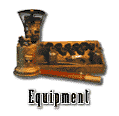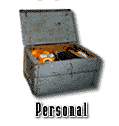
The bush pilot was merely the emissary of an aggressive and expanding society intent on developing northern resources. The pilots were a link between the urban society in the south and the traditional bands of Natives in the north. When they arrived, the Natives would run into their huts or wigwams and come out gaily decorated, dressed in their most brilliant colours. When the machine rode at anchor, they would sit staring at it for hours. Northern Natives supplemented the bush pilots with useful tools, equipment and warm clothing to help them survive in their land.
Click on the icons (left) to see examples of dress, cargo and equipment.

Weight was always a worry. Keeping the machine in the air was more important than eating. Most pilots did not carry any spare clothing but simply a small box of soap to wash their clothes in the lake they landed on. The development of special jobs for bush planes such as flying mining equipment, transporting passengers, mail, groceries and livestock, led to the refinement of design. Larger cargo capacity, effective navigation equipment, reliable and easily maintained engines, became the hallmarks of the successful modern bush plane.

Life preservers, a fish net and an axe made up a standard survival kit which was always calculated as part of the supplies. The advent of aerial photography and survey work implemented the Fairchild F-8 camera for both vertical and oblique photography. An oil heater covered by a canvas cowel shroud was used to warm the engine during the winter months.

Winter flying introduced new sets of hazards. Landing in deep snow and slush meant hours of hard jacking and hoisting up the aircraft with logs cut from the nearby bush. Quite often, the plane would fall through the ice soaking and sometimes losing their cargo. Important personal items such as food were carefully packed and sealed for protection.

















